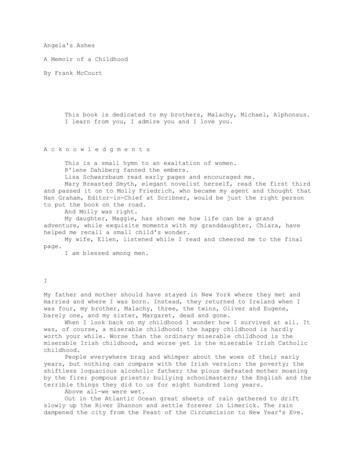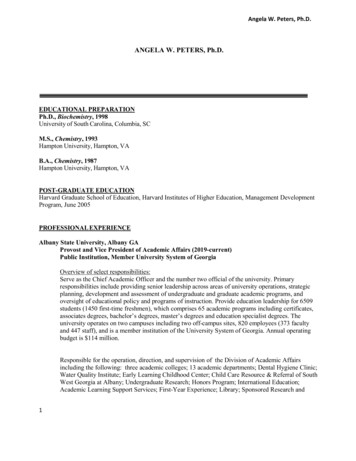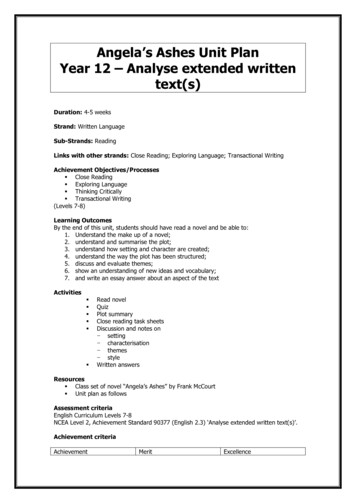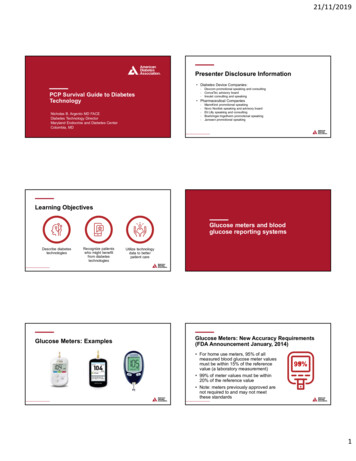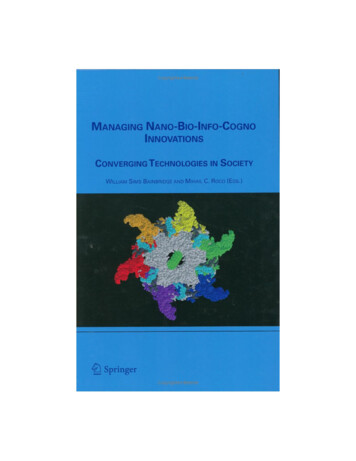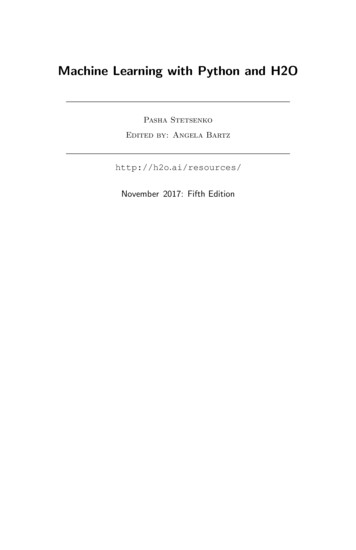
Transcription
Machine Learning with Python and H2OPasha StetsenkoEdited by: Angela Bartzhttp://h2o.ai/resources/November 2017: Fifth Edition
Machine Learning with Python and H2Oby Pasha Stetsenkowith assistance from Spencer Aiello,Cliff Click, Hank Roark, & Ludi RehakEdited by: Angela BartzPublished by H2O.ai, Inc.2307 Leghorn St.Mountain View, CA 94043 2017 H2O.ai, Inc. All Rights Reserved.November 2017: Fifth EditionPhotos by H2O.ai, Inc.All copyrights belong to their respective owners.While every precaution has been taken in thepreparation of this book, the publisher andauthors assume no responsibility for errors oromissions, or for damages resulting from theuse of the information contained herein.Printed in the United States of America.
Contents1 Introduction42 What is H2O?2.1 Example Code . . . . . . . . . . . . . . . . . . . . . . . . . .2.2 Citation . . . . . . . . . . . . . . . . . . . . . . . . . . . . .5663 Installation3.1 Installation in Python . . . . . . . . . . . . . . . . . . . . . .674 Data Preparation4.1 Viewing Data . . . . . . .4.2 Selection . . . . . . . . . .4.3 Missing Data . . . . . . . .4.4 Operations . . . . . . . . .4.5 Merging . . . . . . . . . .4.6 Grouping . . . . . . . . . .4.7 Using Date and Time Data4.8 Categoricals . . . . . . . .4.9 Loading and Saving Data .7910121316171819215 Machine Learning5.1 Modeling . . . . . . . . . . . . . . . . . . . .5.1.1 Supervised Learning . . . . . . . . . .5.1.2 Unsupervised Learning . . . . . . . .5.1.3 Miscellaneous . . . . . . . . . . . . .5.2 Running Models . . . . . . . . . . . . . . . .5.2.1 Gradient Boosting Machine (GBM) . .5.2.2 Generalized Linear Models (GLM) . .5.2.3 K-means . . . . . . . . . . . . . . . .5.2.4 Principal Components Analysis (PCA)5.3 Grid Search . . . . . . . . . . . . . . . . . .5.4 Integration with scikit-learn . . . . . . . . . .5.4.1 Pipelines . . . . . . . . . . . . . . . .5.4.2 Randomized Grid Search . . . . . . .2121222323232427303233343436.6 Acknowledgments387 References38
4 Introduction1IntroductionThis documentation describes how to use H2O from Python. More information on H2O’s system and algorithms (as well as complete Python userdocumentation) is available at the H2O website at http://docs.h2o.ai.H2O Python uses a REST API to connect to H2O. To use H2O in Pythonor launch H2O from Python, specify the IP address and port number of theH2O instance in the Python environment. Datasets are not directly transmittedthrough the REST API. Instead, commands (for example, importing a datasetat specified HDFS location) are sent either through the browser or the RESTAPI to perform the specified task.The dataset is then assigned an identifier that is used as a reference in commandsto the web server. After one prepares the dataset for modeling by definingsignificant data and removing insignificant data, H2O is used to create a modelrepresenting the results of the data analysis. These models are assigned IDsthat are used as references in commands.Depending on the size of your data, H2O can run on your desktop or scaleusing multiple nodes with Hadoop, an EC2 cluster, or Spark. Hadoop is ascalable open-source file system that uses clusters for distributed storage anddataset processing. H2O nodes run as JVM invocations on Hadoop nodes. Forperformance reasons, we recommend that you do not run an H2O node on thesame hardware as the Hadoop NameNode.H2O helps Python users make the leap from single machine based processingto large-scale distributed environments. Hadoop lets H2O users scale their dataprocessing capabilities based on their current needs. Using H2O, Python, andHadoop, you can create a complete end-to-end data analysis solution.This document describes the four steps of data analysis with H2O:1. installing H2O2. preparing your data for modeling3. creating a model using simple but powerful machine learning algorithms4. scoring your models
What is H2O? 52What is H2O?H2O.ai is focused on bringing AI to businesses through software. Its flagshipproduct is H2O, the leading open source platform that makes it easy forfinancial services, insurance companies, and healthcare companies to deploy AIand deep learning to solve complex problems. More than 9,000 organizations and80,000 data scientists depend on H2O for critical applications like predictivemaintenance and operational intelligence. The company – which was recentlynamed to the CB Insights AI 100 – is used by 169 Fortune 500 enterprises,including 8 of the world’s 10 largest banks, 7 of the 10 largest insurancecompanies, and 4 of the top 10 healthcare companies. Notable customersinclude Capital One, Progressive Insurance, Transamerica, Comcast, NielsenCatalina Solutions, Macy’s, Walgreens, and Kaiser Permanente.Using in-memory compression, H2O handles billions of data rows in-memory,even with a small cluster. To make it easier for non-engineers to create completeanalytic workflows, H2O’s platform includes interfaces for R, Python, Scala,Java, JSON, and CoffeeScript/JavaScript, as well as a built-in web interface,Flow. H2O is designed to run in standalone mode, on Hadoop, or within aSpark Cluster, and typically deploys within minutes.H2O includes many common machine learning algorithms, such as generalizedlinear modeling (linear regression, logistic regression, etc.), Naı̈ve Bayes, principalcomponents analysis, k-means clustering, and word2vec. H2O implements bestin-class algorithms at scale, such as distributed random forest, gradient boosting,and deep learning. H2O also includes a Stacked Ensembles method, which findsthe optimal combination of a collection of prediction algorithms using a processknown as ”stacking.” With H2O, customers can build thousands of models andcompare the results to get the best predictions.H2O is nurturing a grassroots movement of physicists, mathematicians, andcomputer scientists to herald the new wave of discovery with data science bycollaborating closely with academic researchers and industrial data scientists.Stanford university giants Stephen Boyd, Trevor Hastie, and Rob Tibshiraniadvise the H2O team on building scalable machine learning algorithms. Andwith hundreds of meetups over the past several years, H2O continues to remaina word-of-mouth phenomenon.Try it out Download H2O directly at http://h2o.ai/download. Install H2O’s R package from CRAN at https://cran.r-project.org/web/packages/h2o/.
6 Installation Install the Python package from PyPI at https://pypi.python.org/pypi/h2o/.Join the community To learn about our training sessions, hackathons, and product updates,visit http://h2o.ai. To learn about our meetups, visit https : / / www.meetup.com /topics/h2o/all/. Have questions? Post them on Stack Overflow using the h2o tag athttp://stackoverflow.com/questions/tagged/h2o. Have a Google account (such as Gmail or Google )? Join the open sourcecommunity forum at https://groups.google.com/d/forum/h2ostream. Join the chat at https://gitter.im/h2oai/h2o-3.2.1Example CodePython code for the examples in this document is located o-docs/src/booklets/v2 2015/source/Python Vignette code examples2.2CitationTo cite this booklet, use the following:Aiello, S., Cliff, C., Roark, H., Rehak, L., Stetsenko, P., and Bartz, A. (Nov 2017).Machine Learning with Python and H2O. http://h2o.ai/resources/.3InstallationH2O requires Java; if you do not already have Java installed, install it fromhttps://java.com/en/download/ before installing H2O.The easiest way to directly install H2O is via a Python package.
Data Preparation 73.1Installation in PythonTo load a recent H2O package from PyPI, run:pip install h2oTo download the latest stable H2O-3 build from the H2O download page:1. Go to http://h2o.ai/download.2. Choose the latest stable H2O-3 build.3. Click the “Install in Python” tab.4. Copy and paste the commands into your Python session.After H2O is installed, verify the installation:123456789101112import h2o# Start H2O on your local machineh2o.init()# Get gEstimator)# Show a demoh2o.demo("glm")h2o.demo("gbm")4Data PreparationThe next sections of the booklet demonstrate the Python interface usingexamples, which include short snippets of code and the resulting output.In H2O, these operations all occur distributed and in parallel and can be usedon very large datasets. More information about the Python interface to H2Ocan be found at docs.h2o.ai.Typically, we import and start H2O on the same machine as the running Pythonprocess:12import h2oh2o.init()To connect to an established H2O cluster (in a multi-node Hadoop environment,for example):1h2o.init(ip "123.45.67.89", port 54321)
8 Data PreparationTo create an H2OFrame object from a Python tuple:123456789101112df h2o.H2OFrame(zip(*((1, 2, 3), (’a’, ’b’, ’c’), (0.1, 0.2, 0.3))))# View the H2OFramedf#C1 C2C3# ---- ---- ---#1 a0.1#2 b0.2#3 c0.3## [3 rows x 3 columns]To create an H2OFrame object from a Python list:123456789101112df h2o.H2OFrame(zip(*[[1, 2, 3], [’a’, ’b’, ’c’], [0.1, 0.2, 0.3]]))# View the H2OFramedf#C1 C2C3# ---- ---- ---#1 a0.1#2 b0.2#3 c0.3## [3 rows x 3 columns]To create an H2OFrame object from collections.OrderedDict or aPython dict:123456789101112df h2o.H2OFrame({’A’: [1, 2, 3],’B’: [’a’, ’b’, ’c’],’C’: [0.1, 0.2, 0.3]})# View the H2OFramedf#AC# --- --#1 0.1#2 0.2#3 0.3## [3 rows xB--abc3 columns]To create an H2OFrame object from a Python dict and specify the columntypes:1234567df2 h2o.H2OFrame.from python({’A’: [1, 2, 3],’B’: [’a’, ’a’, ’b’],’C’: [’hello’, ’all’, ’world’],’D’: [’12MAR2015:11:00:00’, ’13MAR2015:12:00:00’, ’14MAR2015:13:00:00’]},column types [’numeric’, ’enum’, ’string’, ’time’])# View the H2OFrame
Data Preparation 98910111213141516df2#A C# --- ----#1 hello#2 all#3 world## [3 rows x 4B--aabD----------1.42618e 121.42627e 121.42636e 12columns]To display the column types:12df2.types# {u’A’: u’numeric’, u’B’: u’string’, u’C’: u’enum’, u’D’: u’time’}4.1Viewing DataTo display the top and bottom of an 2627282930313233import numpy as npdf h2o.H2OFrame.from python(np.random.randn(100,4).tolist(), column names list(’ABCD’))# View top 10 rows of the 1-1.511310.569406-1.47146-1.35006-0.602646[10 rows x 4 columns]# View bottom 5 rows of the 3-1.13907-0.00489881.13485[5 rows x 4 0306
10 Data PreparationTo display the column names:12df.columns# [u’A’, u’B’, u’C’, u’D’]To display compression information, distribution (in multi-machine clusters),and summary statistics of your 28df.describe()##########################Rows: 100 Cols: 4Chunk compression summary:chunk typechunknamecount-----------------------64-bit RealsC8D4Frame distribution summary:size# rows--------------- ------ -----127.0.0.1:54321 3.4 KB 100mean3.4 KB 100min3.4 KB 100max3.4 KB 100stddev0 B0total3.4 KB l-2.37446-0.231591.919980.9057600count %------100size---3.4 KB# chunks per 3.130140.9613300size %-----100# 90571.0260800SelectionTo select a single column by name, resulting in an 48[100 rows x 1 column]
Data Preparation 11To select a single column by index, resulting in an 9500.5737360.0518831.919987-0.6321820.374212[100 rows x 1 column]To select multiple columns by name, resulting in an 32229[100 rows x 2 columns]To select multiple columns by index, resulting in an 0.5737360.0518831.919987-0.6321820.374212[100 rows x 2 columns]
12 Data PreparationTo select multiple rows by slicing, resulting in an H2OFrame:Note By default, H2OFrame selection is for columns, so to slice by rows andget all columns, be explicit about selecting all columns:1234567891011df[2:7, .92447[5 rows x 4 columns]To select rows based on specific criteria, use Boolean masking:12345678df2[ df2["B"] "a", :]#A C# --- ----#1 hello#2 all## [2 rows x 44.3B--aaD----------1.42618e 121.42627e 12columns]Missing DataThe H2O parser can handle many different representations of missing datatypes, including ‘’ (blank), ‘NA’, and None (Python). They are all displayed asnan in Python.To create an H2OFrame from Python with missing elements:12345678df3 h2o.H2OFrame.from python({’A’: [1, 2, 3,None,’’],’B’: [’a’, ’a’, ’b’, ’NA’, ’NA’],’C’: [’hello’, ’all’, ’world’, None, None],’D’: 00’,None,’14MAR2015:13:00:00’]},column types [’numeric’, ’enum’, ’string’, ’time’])To determine which rows are missing data for a given column (‘1’ indicatesmissing):123456df3["A"].isna()#C1# ---#0#0
Data Preparation 137891011##### [5011rows x 1 column]To change all missing values in a column to a different value:1df3[ df3["A"].isna(), "A"] 5To determine the location of all missing data in an H2OFrame:1234567891011df3.isna()#C1C2C3C4# ---- ---- ---- ---#0000#0001#0000#0001#0000## [5 rows x 4 columns]4.4OperationsWhen performing a descriptive statistic on an entire H2OFrame, missing datais generally excluded and the operation is only performed on the columns ofthe appropriate data type:1234567891011df4 h2o.H2OFrame.from python({’A’: [1, 2, 3,None,’’],’B’: [’a’, ’a’, ’b’, ’NA’, ’NA’],’C’: [’hello’, ’all’, ’world’, None, None],’D’: 00’,None,’14MAR2015:13:00:00’]},column types [’numeric’, ’enum’, ’string’, ’time’])df4.mean(na rm True)# [2.0, nan, nan, nan]When performing a descriptive statistic on a single column of an H2OFrame,missing data is generally not excluded:12345df4["A"].mean()# [nan]df4["A"].mean(na rm True)# [2.0]In both examples, a native Python object is returned (list and float respectivelyin these examples).
14 Data PreparationWhen applying functions to each column of the data, an H2OFrame containingthe means of each column is returned:12345678910df5 h2o.H2OFrame.from python(np.random.randn(100,4).tolist(), column names list(’ABCD’))df5.apply(lambda x: x.mean(na rm 0334168C----------0.0374976D--------0.0520486[1 row x 4 columns]When applying functions to each row of the data, an H2OFrame containing thesum of all columns is returned:1234567891011121314151617df5.apply(lambda row: row.sum(), axis 3-0.7786042.30617[100 rows x 1 column]H2O provides many methods for histogramming and discretizing data. Here isan example using the hist method on a single data frame:1234567891011121314151617df6 h2o.H2OFrame.from ot False)#############Parse Progress: [###############################] 100%breakscountsmids truemidsdensity--------- -------- ----------- ----------- 740318-0.4130930.0959675 88872.9888960.8609692.667450.0933313[8 rows x 5 columns]
Data Preparation 15H2O includes a set of string processing methods in the H2OFrame class thatmake it easy to operate on each element in an H2OFrame.To determine the number of times a string is contained in each element:12345678910111213141516171819df7 h2o.H2OFrame.from python([’Hello’, ’World’, ’Welcome’, ’To’, ’H2O’, ’World’])# View the H2OFramedf7# C1C2C3# ----- ----- ------# Hello World Welcome## [1 row x 6 columns]C4---ToC5---H2OC6----World# Find how many times "l" appears in each stringdf7.countmatches(’l’)#C1C2C3C4# ---- ---- ---- ---#2110## [1 row x 6 columns]C5---0C6---1To replace the first occurrence of ‘l’ (lower case letter) with ‘x’ and return anew orxdFor global substitution, use gsub. Both sub and gsub support regularexpressions.To split strings based on a regular expression:1234567df7.strsplit(’(l) ’)#####C1---HeC2---oC3---WorC4---d[1 row x 10 ----d
16 Data Preparation4.5MergingTo combine two H2OFrames together by appending one as rows and return anew H2OFrame:1234567891011121314151617181920212223# Create a frame of random numbers w/ 100 rowsdf8 h2o.H2OFrame.from python(np.random.randn(100,4).tolist(), column names list(’ABCD’))# Create a second frame of random numbers w/ 100 rowsdf9 h2o.H2OFrame.from python(np.random.randn(100,4).tolist(), column names list(’ABCD’))# Combine the two frames, adding the rows from df9 to .152953[200 rows x 4 columns]For successful row binding, the column names and column types between the twoH2OFrames must match. To combine two H2O frames together by appendingone as columns and return a new 19-1.3460.959-0.1702.1550.017-2.237-0.456[100 rows x 8 52-2.090.631.421.45-0.05
Data Preparation 17H2O also supports merging two frames together by matching column 0 h2o.H2OFrame.from python( {’A’: [’Hello’, ’World’, ’Welcome’, ’To’, ’H2O’, ’World’],’n’: [0,1,2,3,4,5]} )# Create a single-column, 100-row frame# Include random integers from 0-5df11 h2o.H2OFrame.from python(np.random.randint(0,6,(100,1)), column names list(’n’))# Combine column "n" from both datasetsdf11.merge(df10)#n A# --- ------#2 Welcome#5 World#4 H2O#2 Welcome#3 To#3 To#1 World#1 World#3 To#1 World## [100 rows x 2 columns]4.6Grouping”Grouping” refers to the following process: splitting the data into groups based on some criteria applying a function to each group independently combining the results into an H2OFrameTo group and then apply a function to the results:1234567891011121314151617df12 h2o.H2OFrame({’A’ : [’foo’, ’bar’, ’foo’, ’bar’, ’foo’, ’bar’, ’foo’, ’foo’],’B’ : [’one’, ’one’, ’two’, ’three’, ’two’, ’two’, ’one’, ’three’],’C’ : np.random.randn(8).tolist(),’D’ : np.random.randn(8).tolist()})# View the 332331.123210.5124491.351580.00830419
18 Data Preparation18192021222324252627282930# foo0.634827one# foo0.879319three## [8 rows x 4 columns]1.258971.48051df12.group by(’A’).sum().frame# Asum Csum B# --- -------- ------# bar2.166723# foo -1.334245## [2 rows x 4 columns]sum D--------0.08752065.46746To group by multiple columns and then apply a function:123456789101112131415df13 df12.group by([’A’,’B’]).sum().frame# View the H2OFramedf13# ABsum C# --- ----- ---------# bar one-0.165891# bar three2.25083# bar two0.0817828# foo one-0.0752683# foo three0.879319# foo two-2.13829## [6 rows x 4 columns]sum 512.47479Use merge to join the results into the original H2OFrame:1234567891011121314df12.merge(df13)# AB# --- ----# foo one# bar one# foo two# bar three# foo two# bar two# foo one# foo three## [8 rows by 48051sum 290.0817828-0.07526830.879319sum .008304191.512161.48051columns]Using Date and Time DataH2O has powerful features for ingesting and feature engineering using timedata. Internally, H2O stores time information as an integer of the number ofmilliseconds since the epoch.To ingest time data natively, use one of the supported time input formats:
Data Preparation 1912345678df14 h2o.H2OFrame.from python({’D’: ,’20OCT2015:13:00:00’]},column types [’time’])df14.types# {u’D’: u’time’}To display the day of the month:1234567df14[’D’].day()#D# --# 18# 19# 20To display the day of the nTue4.8CategoricalsH2O handles categorical (also known as enumerated or factor) values in anH2OFrame. This is significant because categorical columns have specifictreatments in each of the machine learning algorithms.Using ‘df12’ from above, H2O imports columns A and B as categorical/enumerated/factor types:12df12.types# {u’A’: u’enum’, u’C’: u’real’, u’B’: u’enum’, u’D’: u’real’}To determine if any column is a categorical/enumerated/factor type:12df12.anyfactor()# TrueTo view the categorical levels in a single column:12df12["A"].levels()# [’bar’, ’foo’]
20 Data PreparationTo create categorical interaction ’,’B’], pairwise False, max factors 3, min occurrence 1)# A B# ------# foo one# bar one# foo two# other# foo two# other# foo one# other## [8 rows x 1 column]To retain the most common categories and set the remaining categories to acommon ‘Other’ category and create an interaction of a categorical columnwith itself:1234567891011121314151617bb df df12.interaction([’B’,’B’], pairwise False, max factors 2,min occurrence 1)# View H2OFramebb df# B B# ----# one# one# two# other# two# two# one# other## [8 rows x 1 column]These can then be added as a new column on the original dataframe:1234567891011121314151617df15 df12.cbind(bb df)# View otwoonethree[8 rows x 5 456449-1.336250.308092-0.92675B B----oneonetwoothertwotwooneother
Machine Learning 214.9Loading and Saving DataIn addition to loading data from Python objects, H2O can load data directlyfrom: disk network file systems (NFS, S3) distributed file systems (HDFS) HTTP addressesH2O currently supports the following file types: CSV (delimited) filesORCSVMLiteParquet ARFFXLSXLSXAVROTo load data from the same machine running H2O:1df h2o.upload file("/pathToFile/fileName")To load data from the machine(s) running H2O to the machine running Python:1df h2o.import file("/pathToFile/fileName")To save an H2OFrame on the machine running H2O:1h2o.export file(df,"/pathToFile/fileName")To save an H2OFrame on the machine running Python:1h2o.download csv(df,"/pathToFile/fileName")5Machine LearningThe following sections describe some common model types and features.5.1ModelingThe following section describes the features and functions of some commonmodels available in H2O. For more information about running these models in
22 Machine LearningPython using H2O, refer to the documentation on the H2O.ai website or to thebooklets on specific models.H2O supports the following models: Deep Learning Naı̈ve Bayes Principal Components Analysis (PCA) K-means Stacked Ensembles XGBoost Generalized Linear Models (GLM) Gradient Boosting Machine (GBM) Generalized Low Rank Model(GLRM) Distributed Random Forest (DRF) Word2vecThe list continues to grow, so check www.h2o.ai to see the latest additions.5.1.1Supervised LearningGeneralized Linear Models (GLM): Provides flexible generalization of ordinary linear regression for response variables with error distribution models otherthan a Gaussian (normal) distribution. GLM unifies various other statisticalmodels, including Poisson, linear, logistic, and others when using 1 and 2regularization.Distributed Random Forest: Averages multiple decision trees, each createdon different random samples of rows and columns. It is easy to use, non-linear,and provides feedback on the importance of each predictor in the model, makingit one of the most robust algorithms for noisy data.Gradient Boosting Machine (GBM): Produces a prediction model in theform of an ensemble of weak prediction models. It builds the model in astage-wise fashion and is generalized by allowing an arbitrary differentiable lossfunction. It is one of the most powerful methods available today.Deep Learning: Models high-level abstractions in data by using non-lineartransformations in a layer-by-layer method. Deep learning is an example ofsupervised learning, which can use unlabeled data that other algorithms cannot.Naı̈ve Bayes: Generates a probabilistic classifier that assumes the value of aparticular feature is unrelated to the presence or absence of any other feature,given the class variable. It is often used in text categorization.Stacked Ensembles: Using multiple models built from different algorithms,Stacked Ensembles finds the optimal combination of a collection of predictionalgorithms using a process known as ”stacking.”
Machine Learning 23XGBoost: XGBoost is an optimized gradient boosting library that implementsmachine learning algorithms under the Gradient Boosting Machine (GBM)framework. For many problems, XGBoost is the one of the best GBM frameworkstoday. In other cases, the H2O GBM algorithm comes out on top. Bothimplementations are available on the H2O platform.5.1.2Unsupervised LearningK-Means: Reveals groups or clusters of data points for segmentation. Itclusters observations into k-number of points with the nearest mean.Principal Component Analysis (PCA): The algorithm is carried out on a setof possibly collinear features and performs a transformation to produce a newset of uncorrelated features.Generalized Low Rank Model (GLRM): The method reconstructs missingvalues and identifies important features in heterogeneous data. It also recognizesa number of interpretations of low rank factors, which allows clustering ofexamples or of features.Anomaly Detection: Identifies the outliers in your data by invoking the deeplearning autoencoder, a powerful pattern recognition model.5.1.3MiscellaneousWord2vec: Takes a text corpus as an input and produces the word vectors asoutput. The result is an H2O Word2vec model that can be exported as a binarymodel or as a MOJO.5.2Running ModelsThis section describes how to run the following model types: Gradient Boosting Machine (GBM) Generalized Linear Models (GLM) K-means Principal Components Analysis (PCA)This section also shows how to generate predictions.
24 Machine Learning5.2.1Gradient Boosting Machine (GBM)To generate gradient boosting machine models for creating forward-learningensembles, use H2OGradientBoostingEstimator.The construction of the estimator defines the parameters of the estimator and thecall to H2OGradientBoostingEstimator.train trains the estimator onthe specified data. This pattern is common for each of the H2O 2526272829303132333435363738394041424344In [1]: import h2oIn [2]: h2o.init()Checking whether there is an H2O instance running at http://localhost:54321. not found.Attempting to start a local H2O server.Java Version: java version "1.8.0 25"; Java(TM) SE Runtime Environment (build 1.8.0 25-b17); Java HotSpot(TM) 64-Bit Server VM (build 25.25b02, mixed mode)Starting server from /usr/local/h2o jar/h2o.jarIce root: mpHpRzVeJVM stdout: mpHpRzVe/h2o techwriter started from python.outJVM stderr: mpHpRzVe/h2o techwriter started from python.errServer is running at http://127.0.0.1:54321Connecting
Machine Learning with Python and H2O by Pasha Stetsenko with assistance from Spencer Aiello, Cli Cl
